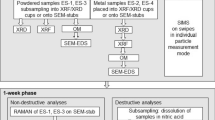Abstract
In 2017, the Nuclear Forensics International Technical Working Group organized their fifth Collaborative Materials Exercise (CMX-5). The exercise samples were two uranium dioxide fuel pellets manufactured from the same starting materials by different processes to have similar bulk isotopic composition, but different spatial uranium isotopic distributions. Sets of identical materials were sent to all participating laboratories, who then utilized their existing nuclear forensic capabilities to independently analyse fuel pellets and identify similarities and differences of the materials’ characteristics. Here we present and compare the ability of different analytical techniques to spatially resolve uranium isotopic heterogeneity in the uranium oxide fuel pellets.













source terms (i) and a detail of the graph around the average composition (ii). The MC-ICP-MS and LG- and SG-SIMS trendlines represent the average from Figs. 4, 6. *The “Primary source terms” are the DU and LEU powders used by CEA. **The “LEU source terms” are the LEU powders mixed by AREVA to make the LEU powder used by CEA. No 234U/238U were provided for the AREVA LEU powders, and therefore a range of possible 234U/238U compositions that could result in the reported CEA LEU powder 234U/238U composition is indicated by the dashed blue error bars
Similar content being viewed by others
References
IAEA (2015) Nuclear forensics in support of investigations. IAEA, Vienna
Nuclear Security Summit. [Online] 2016. http://www.nss2016.org/past-summits/2010. Accessed 6 July 2020
The Global Initiative to Combat Nuclear Terrorism. [Online] August 5, 2009. http://www.nti.org/analysis/articles/initiative-combat-nuclear-terrorism/#fn4. Accessed 6 July 2020
Koch L, Niemeyer S (1996) A report on recent international progress for enhancing nuclear forensic capabilities for cases of illicit nuclear materials. IAEA, Vols. IAEA-CN-86-67, pp 1–26
Taylor F, Higginson M, Marsden O, Schwantes J (2020) State of practice and emerging application of analytical techniques of nuclear forensic analysis: highlights from the 5th collaborative materials exercise of the Nuclear Forensics International Technical Working Group (ITWG). J Radioanal Nucl Chem 323:415–430
Nelwamondo AN, Colletti LP, Lindvall RE, Vesterlund A, Xu N, Hiong Jun Tan A, Eppich GR, Genetti VD, Kokwane BL, Lagerkvist P, Kin PB, Rameback H, Tandon L, Rasmussen G, Varga Z, Wallenius M (2018) Uranium assay and trace element analysis of the fourth collaborative material exercise samples by the modified Davies–Gray method and ICP-MS/OES techniques. J Radioanal Nucl Chem 315:379–394
Stebelkov V, Elantyev I, Hedberg M, Wallenius M, Faure A-L (2018) Determination of isotopic composition of uranium in the CMX-4 samples by SIMS. J Radioanal Nucl Chem 315:417–423
Keegan E, Kristo MJ, Toole K, Kips R, Young E (2016) Nuclear forensics: scientific analysis supporting law enforcement and nuclear sacurity investigations. Anal Chem 88:1496–1505
Hutcheon I, Borg L (2020) Forensic analysis of samples from the nuclear fuel cycle. LLNL-TR-636458. https://www.osti.gov/biblio/1080397/. Accessed 6 July 2020
Mayer K, Wallenius M, Varga Z (2015) Interviewing a silent (radioactive) witness through nuclear forensic analysis. Anal Chem 87:11605–11610
Kips R, Weber PK, Kristo M, Jacobsen B, Ramon E (2019) Microscale isotopic variation observed in uranium fuel pellets with implications for nuclear forensics. Anal Chem 91:11598–11605
Fallon CM, Bower WR, Lyon IC, Livens FR, Thompson P, Higginson M, Collins J, Heath SL, Law GTW (2020) Isotopic and compositional variations in single nuclear fuel pellet particles analyzed by nanoscale secondary ion mass spectrometry. ACS Omega 5:296–303
Krachler M, Varga Z, Nicholl A, Wallenius M, Mayer K (2018) Spatial Distribution of uranium isotopes in solid nuclear materials using laser ablation multi-collector ICP-MS. Microchem J 140:24–30
Varga Z, Wallenius M, Nicholl A, Mayer K (2020) Assessment of uranium inhomogeneity and isotope imaging for nuclear forensics. Spectrochim Acta B. https://doi.org/10.1016/j.sab.2020.105920
Esaka F, Watanabe K, Fukuyama H, Onodera T, Esaka KT, Magar M (2004) Efficient isotope ratio analysis of uranium particles in swipe samples by total-reflection x-ray fluorescence spectrometry and secondary ion mass spectrometry. J Nucl Sci Technol 11:1027–1032
Hedberg PML, Peres P, Cliff JB, Rabemananjara F, Littmann S, Thiele H, Vincent C, Albert N (2011) Improved particle location and isotopic screening measurements of sub-micron sized particles by secondary ion mass spectrometry. J Anal At Spectrom 26:406–413
Parsons-Davis T, Knight K, Fitzgerald M, Stone G, Caldeir L, Ramon C, Kristo M (2018) Application of modern radiography to nuclear forensic analysis. Forensic Sci Int 286:223–232
Pett-Ridge J, Weber P (2012) Applications for Microbiology. In: Navid A (ed) Microbial systems biology: methods and protocols, methods in molecular biology 881, Springer protocols. Humana Press, New York, pp 375–408
Acknowledgements
Lawrence Livermore National Laboratory (LLNL) personnel thank Patrick M. Grant for his leadership and Christina E. Ramon for technical support; work at LLNL was conducted under the auspices of the U.S. Department of Energy under Contract DE-AC52-07NA27344.
Author information
Authors and Affiliations
Corresponding authors
Additional information
Publisher's Note
Springer Nature remains neutral with regard to jurisdictional claims in published maps and institutional affiliations.
Electronic supplementary material
Below is the link to the electronic supplementary material.
Rights and permissions
About this article
Cite this article
Jovanovic, S.V., Weber, P.K., Pidduck, A.J. et al. Uncovering uranium isotopic heterogeneity of fuel pellets from the fifth collaborative materials exercise of The Nuclear Forensics International Technical Working Group. J Radioanal Nucl Chem 326, 1853–1866 (2020). https://doi.org/10.1007/s10967-020-07470-5
Received:
Accepted:
Published:
Issue Date:
DOI: https://doi.org/10.1007/s10967-020-07470-5




